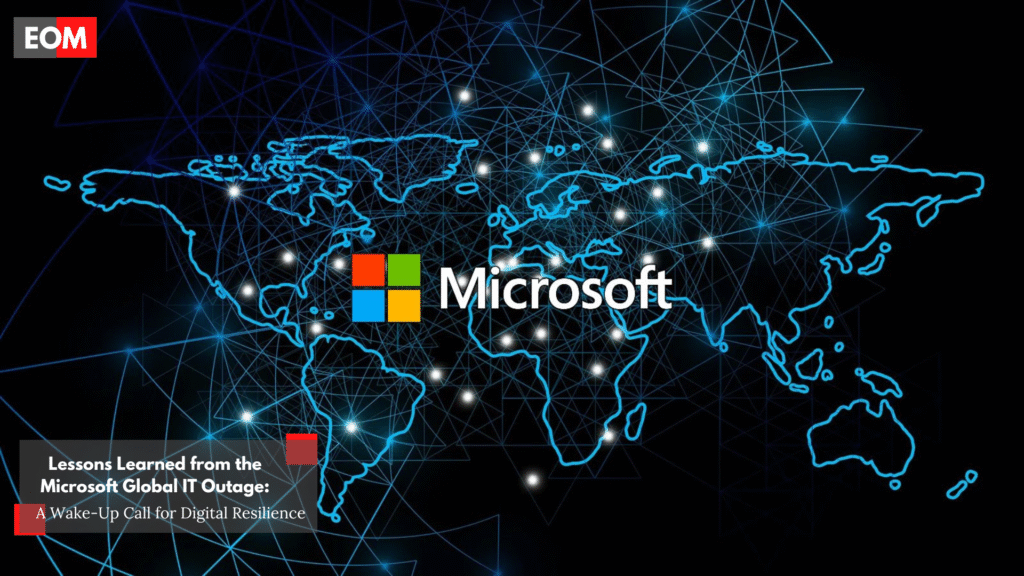Lessons Learned from the Microsoft Global IT Outage: A Wake-Up Call for Digital Resilience

July 2025 – Global
The recent Microsoft global IT outage served as a powerful reminder of the fragility of modern digital infrastructure and the sweeping impact a single point of failure can have on businesses and users worldwide. Affecting critical services like Azure, Microsoft 365, Outlook, and Teams, the outage disrupted workstreams, strained communications, and underscored the need for stronger risk mitigation strategies.
As businesses increasingly lean on cloud platforms for operational continuity, collaboration, and communication, this event has surfaced urgent lessons for both technology providers and enterprise customers.
The Scope and Disruption
Overview of the Incident
In the early hours of the outage, users globally began reporting issues accessing Microsoft services. Core platforms—including Office 365, OneDrive, Teams, and Azure-hosted apps—were either slow or entirely inaccessible. From internal communications to cloud-based workflows, organizations of every size felt the ripple effects.
Timeline of Events
- Morning (GMT): Outage begins; reports of access issues flood social media and Microsoft forums.
- Midday: Microsoft issues its first official response, confirming disruptions and initiating diagnostics.
- Afternoon: Restoration begins in phased regions; temporary workarounds suggested.
- Evening: Most global services are restored; Microsoft announces root-cause investigation.
Immediate Impact on Users and Enterprises
Operational Disruption
Remote teams were hit especially hard, losing access to mission-critical tools during peak business hours. Email delays, missed client meetings, stalled file sharing, and halted development pipelines created financial and reputational risks, especially for service-based industries and international organizations.
Productivity Breakdown
From global retailers and financial institutions to small creative agencies, the inability to access Teams or SharePoint derailed projects, strained client communications, and forced companies to rely on ad hoc channels like WhatsApp, Zoom, and Google Drive for temporary relief.
Key Lessons for the Future
1. Digital Infrastructure Needs More Redundancy
While Microsoft maintains a vast network of globally distributed data centers, the incident revealed gaps in failover systems and load balancing mechanisms. For customers, it’s a call to diversify cloud vendors, establish hybrid architectures, and build redundancies into mission-critical processes.
Lesson: A single-cloud dependency is a single point of failure.
2. Communication Is Everything During a Crisis
Microsoft did issue multiple updates during the outage, but many users noted a lack of detailed, real-time transparency, especially in the early hours. Businesses need clearer channels for receiving outage updates and contingency guidance.
Lesson: Crisis communication must be proactive, not reactive—and tailored to enterprise clients’ needs.
3. Contingency Planning Is No Longer Optional
Organizations without backup tools or offline workflows were disproportionately affected. The incident reinforced the importance of disaster recovery planning, including:
- Data backup strategies
- Offline access protocols
- Manual overrides for essential services
- Cross-training employees for non-digital operations
Lesson: Business continuity must be designed for digital failure.
Proactive Steps for Business Leaders
Strengthen IT Resilience
- Perform regular stress testing on infrastructure.
- Build cross-cloud or multi-region support into service architecture.
- Audit system dependencies and identify single points of failure.
Enhance Response Capabilities
- Establish a dedicated incident response team.
- Develop an internal communications plan for technology outages.
- Align with vendors on SLAs and response expectations.
Invest in Workforce Preparedness
- Train employees on alternate tools and processes.
- Empower teams to make decisions during disruptions.
- Encourage documentation of workflows and emergency procedures.
Looking Ahead: Turning Disruption into Transformation
The Microsoft global outage wasn’t just a technical failure—it was a business wake-up call. As enterprises deepen their reliance on digital tools, resilience must become a strategic priority. This means treating IT not just as a support function, but as a pillar of business continuity.
For Microsoft, the event has already triggered internal reviews and promises of improved system architecture. For its customers, the time is now to review vendor risk, rethink digital workflows, and prepare for the next unexpected interruption.
Conclusion
Outages are inevitable in a connected world—but unpreparedness isn’t. By learning from Microsoft’s recent misstep and reinforcing proactive infrastructure, communication, and contingency strategies, organizations can weather disruptions more effectively.
In a digital-first economy, resilience is no longer an IT issue—it’s a leadership imperative.

